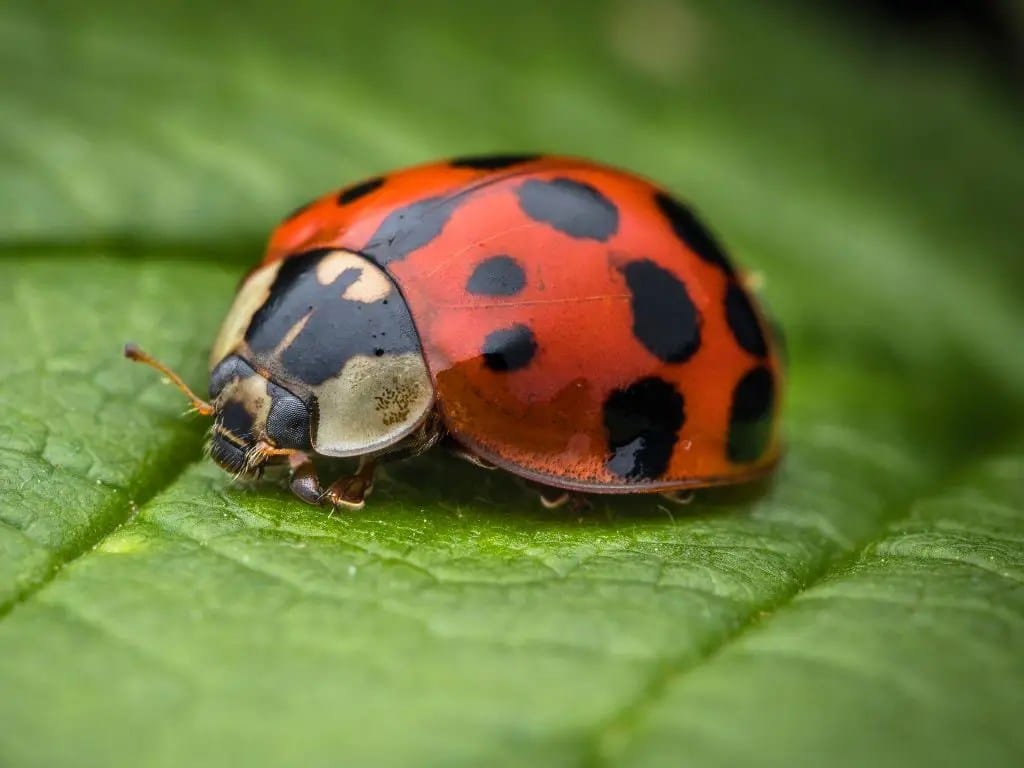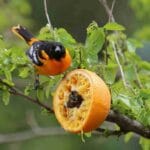What Eats Ladybugs? Unveiling Their Hungry Hunters
Those cheerful ladybugs dotting our gardens aren’t just charming visitors – they’re a tasty treat for a surprising number of backyard predators. Their vibrant shells and friendly reputation might seem protective, but ladybugs have a whole lineup of creatures looking to make a meal of them. Let’s dive into the exciting, and sometimes perilous, world of ladybug predators!
Birds: From the Sky to a Ladybug’s Worst Nightmare
Those cheerful birds flitting around your yard – robins, sparrows, swallows – often consider ladybugs a delicious part of their diet. Birds are particularly adept at snatching ladybugs mid-flight, turning a leisurely bug’s journey into a sudden plunge into a hungry beak! Even those bright ladybug colors don’t seem to scare them off!
Not Just Birds: A Whole Cast of Ladybug-Loving Critters
Birds aren’t the only ones with a taste for ladybugs. Down on the ground, you’ll find hopping, slithering, and crawling critters who wouldn’t turn down a ladybug snack. Amphibians like frogs and toads love to scoop them up with their long tongues. And don’t forget about those stealthy hunters: spiders patiently waiting in their webs or cunning praying mantises staging ambushes. Even other insects, like the impressive dragonfly, are known to snatch ladybugs right out of the air!
Cannibalism: When Ladybugs Turn on Each Other
This one might sound surprising, but sometimes a ladybug’s biggest threat is… another ladybug! If times get tough and food is scarce, ladybugs have been known to eat their own kind, especially the eggs, larvae, and pupae. While it seems a bit harsh, this ladybug-on-ladybug action is actually nature’s way of keeping things in balance.
Ladybug Defense Tactics: Not Completely Defenseless!
Of course, ladybugs aren’t just going down without a fight! Over time, they’ve developed some pretty clever ways to avoid becoming someone else’s lunch. Those bright colors we find so charming actually serve as a warning signal to predators, advertising that ladybugs might not be that tasty and could even be toxic. If a threat gets too close, a ladybug can release a stinky, unpleasant liquid from its legs – an effective deterrent! And sometimes, ladybugs resort to playing dead, hoping that a potential predator will lose interest and move on.
A Delicate Balance: Why Ladybug Predators Matter
So, why should we care about what eats ladybugs? It all comes down to the interconnectedness of nature. Ladybugs play a crucial role in keeping our gardens healthy by munching on pests and even helping with pollination. But if ladybug populations dwindle because of too many predators, it can throw the whole ecosystem off balance. By understanding the complex relationships between ladybugs and their predators, we can create gardens and environments that support these beneficial bugs and all the good they do. Uncover the fascinating feeding habits of ladybugs in what do ladybugs eat and drink.
Unleashing the Power of Natural Selection: What Kills Ladybugs?
Ladybugs, despite their vibrant colors and beneficial reputation, are far from invincible. They face a surprising array of natural predators, from stealthy assassins of the insect world to opportunistic amphibians. The list reads like a who’s who of the animal kingdom!
Who’s on the Ladybug Hit List?
It’s a wild world out there, and ladybugs have a surprising number of natural enemies:
- Birds: Think graceful swallows and zippy martins snatching them out of the air or swifts grabbing a quick snack on the go. For the melodious mockingbirds, delve into the world of their culinary choices in what do mockingbirds eat.
- Insects: Even ladybugs have to watch out for bullies! Dragonflies, praying mantises, and assassin bugs are always up for ladybug lunch. Then you’ve got sneaky parasitic wasps laying eggs on them, and lace bugs competing for their food.
- Amphibians: Don’t forget about tree frogs and American toads—they think ladybugs are pretty tasty too!
- Other Unexpected Threats: This is where it gets really interesting. Ants might decide a ladybug looks tasty, anole lizards won’t say no to a quick bite, and even certain types of fungi can be dangerous. And the most shocking of all? Sometimes, ladybugs even eat each other!
Don’t Worry, Ladybugs Have Tricks Up Their Sleeves!
You might be thinking, “How do ladybugs survive with all those predators?!” Well, they’re not defenseless! They’ve got some clever tricks to stay alive:
- Warning Colors: Those vibrant red and orange colors aren’t just for show. They’re a big sign to predators saying, “Hey, I taste awful, don’t even try me!”
- Stinky Surprise: If a predator does get too close, ladybugs release a super smelly, toxic liquid from their legs. It’s not deadly, but it’s definitely not pleasant!
- Playing Dead: Sometimes, the best defense is a good offense…or a very convincing act! Ladybugs will often play dead to avoid becoming a meal.
It’s All About Balance
The relationship between ladybugs and their predators is a constant balancing act. Some ladybugs are aphid-eating specialists, while others, like the convergent ladybug beetle, have specific predators they’ve adapted to. This creates a specialized dance of predator and prey that keeps things in check.
How You Can Help
Knowing what threatens ladybugs can help you make your garden a ladybug haven! Offering them different food sources and cozy shelters can help them thrive and keep those pesky predators at bay. It’s all about building a healthy ecosystem right in your backyard.
The Big Picture
Ladybugs might be small, but they’re a big part of a complex and fascinating world. By understanding what kills them naturally, we get a glimpse into the delicate balance of nature and learn how to protect these helpful creatures.
Beyond the Bright Colors: The Surprising Creatures That Feast on Dead Ladybugs
While vibrant ladybugs might deter some predators in life, even their bright shells offer little protection in death. This ushers in a different set of opportunistic diners. Think ladybugs are just for the birds? Think again! A surprising array of creatures, large and microscopic, consider these beetles a convenient meal – even after death.
The Decomposition Process Unveiled
The decomposition of a ladybug doesn’t just involve scavengers; it’s a complex process fueled by microorganisms, transforming these colorful beetles into essential nutrients. From the backyard to the forest floor, the humble ladybug’s demise plays a vital role in the intricate food webs that sustain our ecosystems.
Potential Consumers of Dead Ladybugs
While there isn’t a ton of research specifically on what eats dead ladybugs, we can use some common sense.
Since ladybugs hang out in gardens and fields, it’s gotta be creatures that live in those places too, right? We know ants love a good scavenging session, and earwigs aren’t picky eaters when it comes to decaying stuff. It’s even possible that other insects, like beetles, might join in on the ladybug buffet.
The Importance of Decomposition
The truth is, the world of insects is full of surprises, and we still have a lot to learn about these tiny ecosystems. What we do know is that even in death, ladybugs contribute to the delicate balance of nature. So, the next time you see a ladybug, remember that its life, even after it’s over, plays a vital role in the grand scheme of things.
Ladybugs: The Good, the Bad, and the Hungry – Unmasking the Hidden Side of These Garden Visitors
While renowned for their aphid-gobbling prowess and charming appearance, ladybugs aren’t always the beneficial garden guests we perceive them to be. Let’s uncover the hidden side of these spotted insects, exploring both their upsides and downsides.
Not All Ladybugs are Beneficial
Most ladybug species are carnivorous, cheerfully devouring soft-bodied insects like aphids, mites, and scale insects, making them valuable allies in natural pest control. However, some species, like the Mexican bean beetle and squash beetle, are herbivores, posing a threat to gardens and crops.
- Mexican Bean Beetle: This species targets various bean plants, causing significant damage to leaves and pods.
- Squash Beetle: As the name suggests, this ladybug feeds on squash, pumpkins, and other cucurbits, impacting yields.
Ladybug Defenses and Potential Nuisances
When threatened, ladybugs release a yellowish fluid from their leg joints called hemolymph. This fluid contains a foul-smelling, bitter compound that deters predators. While generally harmless, the hemolymph can trigger allergies in some individuals, causing skin irritations, sneezing, or itchy eyes.
During fall and winter, ladybugs often seek shelter in warm places, leading to potential infestations inside homes. Though harmless individually, large numbers can be a nuisance, staining surfaces with their defensive fluids and emitting an unpleasant odor.
Impact of Pesticides
While pesticides can control garden pests, they also harm beneficial insects like ladybugs.
- Collateral Damage: Using broad-spectrum pesticides can disrupt the natural balance of ecosystems by reducing ladybug populations, potentially leading to a resurgence of other pests.
People’s Statements:
- “Ladybugs are not harmful to humans at all unless you’re allergic to their tiny bites.” – Ladybug Planet
- “They can exude a foul smell to ward off predators and are even poisonous to some predators.” – Ladybug Planet
- “They are toxic for some other small insects to eat.” – Ladybug Planet
Responsible Pest Management
Understanding the potential downsides of ladybugs allows for more responsible pest management in our gardens. By choosing targeted approaches that minimize harm to beneficial insects and promoting a balanced ecosystem, we can enjoy the benefits of ladybugs without inadvertently causing harm.
- Crypto Quotes’ Red Flags: Avoid Costly Mistakes - June 30, 2025
- Unlock Inspirational Crypto Quotes: Future Predictions - June 30, 2025
- Famous Bitcoin Quotes: A Deep Dive into Crypto’s History - June 30, 2025
















